

| Home | For sale | Site map | Contact information | Guest book | Stielhandgranate 24 menu |
 Stielhandgranate
24 Stielhandgranate
24  |
|---|
|
The Übungs-Stielhandgranate 24  The Wehrmacht always tried to give their personnel the best possible training before soldiers were sent into combat. Most weapon systems came with a training system or device. This was also the case with the Stielhandgranate 24. The Übungs-Stielhandgranate 24 (training stick handgrenade model 24) followed quickly after the introduction of the Stielhandgranate 24. It closely resembled the original in weight and form, but the head was specially constructed. The upper part had 8 holes for gas evacuation, and the top was concave to better withstand the gas pressure created by the training charge. The lower part of the head that held the threads was pressed on the upper and secured with 6 rivets. The thicker metal used for the head compensated the weight for the missing explosives. Both the head and the raincap on the handle was painted red, for ease of observation once thrown and to avoid confusing it with a real Stielhandgranate 24. It is a common misconception that the handle was identical to a "live" Stielhandgranate 24, except for the red paint and marking. The Übungs-handle had a reinforced thread cap to better withstand the gas pressure from the Übungsladung. A steel insert was spot welded inside the cap and threaded for the Brennzünder.  A handle from a Stielhandgranate 24 compared with a handle from a Übungs-Stielhandgranate 24. Note the added thickness to the threaded cap, and the 4 marks from the spot welding, better visible in the picture to the right. 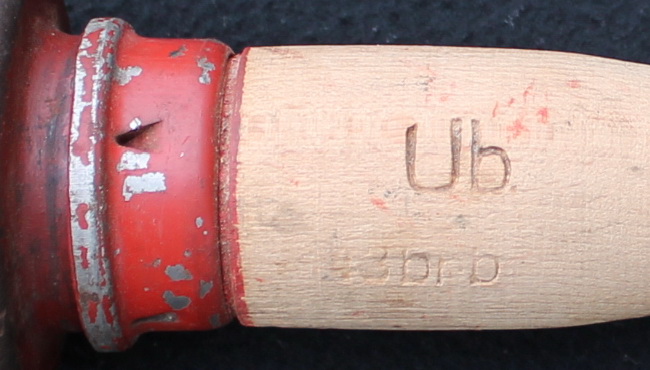 The handle was marked with "Ueb", "Üb" or "Ub" in the same area as the standard markings were applied to the handle. 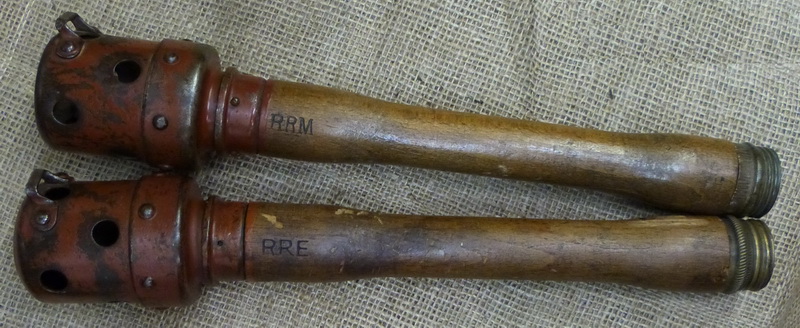 Picture courtesy of Nick Jeans, UK The first version of the Übungs-Stielhandgranate 24 had a Trageöse (carrying eyelet) that was riveted to the head, close to the top. This eyelet would be used together with a special spring, a "Tragefeder" (carrying spring) that attached to the bayonet frog on the belt. The Trageöse resembled the one welded to the first version of the Stielhandgranate 24, but on the Übungs-Stielhandgranate 24 it was much sturdier. The two grenades above were manufactured by Richard Rinker in 1927 (M) and in 1931 (E). The Trageöse was discontinued on the training handgrenade in 1933. The production of the Übungs-Stielhandgranate 24 followed the standard production, with the same simplifications to the manufacturing process. 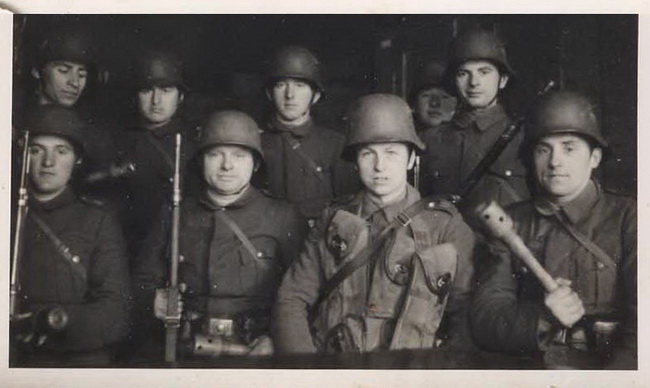 Reichswehr soldiers posing, ready for training. There are four Übungs-Stielhandgranaten visible in the picture. The handling and priming of the Übungs-Stielhandgranate 24 was done in the same manner as the Stielhandgranate, except for the fact that the detonator was exchanged for a Übungsladung 24 or 30. 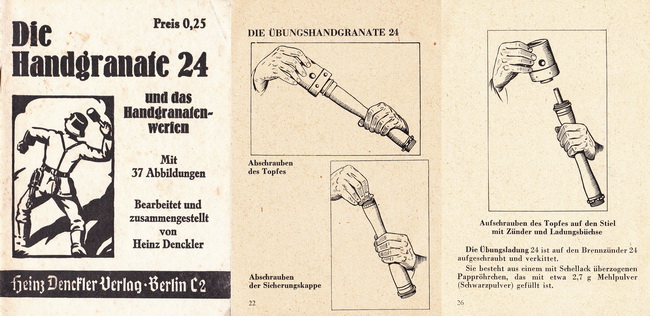 See pages 21 to 27 in the publication "Die Handgranate 24 und das Handgranatenwerfen". The Übungsladung 24 consisted of a lacquered cardboard tube filled with 2.7 grams of black powder. According to the manual above it was delivered already attached and sealed to the Brennzünder 24. No picture of the Übungsladung 24 is known to exist, apart from the drawings in the manual mentioned above. 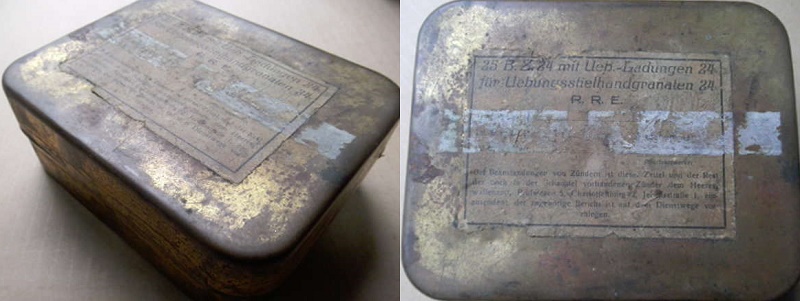 (Picture courtesy of Glaser on WAF) But at least an example of the box has survived. Manufactured by Richard Rinker in 1931 (R.R.E.). Note the text: 25 B.Z.24 mit Ueb.-Ladungen 24 für Uebungsstielhandgranaten 24 This training charge must have been unsatisfactory, both in construction and handling, as the replacement came swiftly. The new model was called the Übungsladung 30. The standard Brennzünder 24 could now be used, as the mushroom-shaped Übungsladung 30 simply screwed on to the end of the Brennzünder, replacing the detonator in the live handgrenade. The mushroom contained a charge of black powder and was constructed to disintegrate into two large pieces that would be too big to escape through the gas-escape holes in the head. 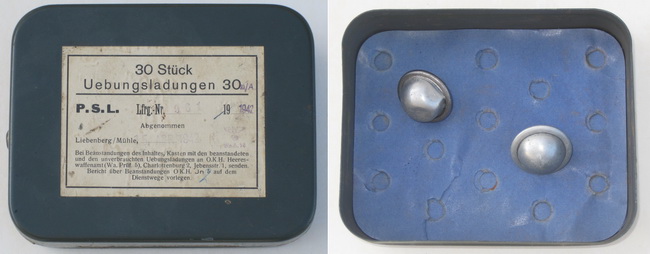 Picture courtesy of Tom Ø. 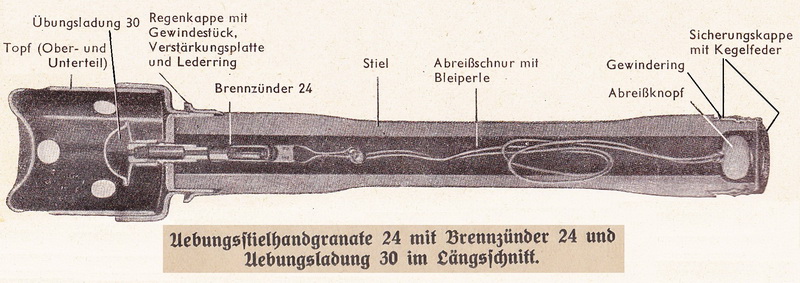 A cut-through picture from the 1940 dated manual "Waffentechnische Unterrichtsbuch" by Schmitt. Note the added thickness to the thread cap and the concave top to the head. 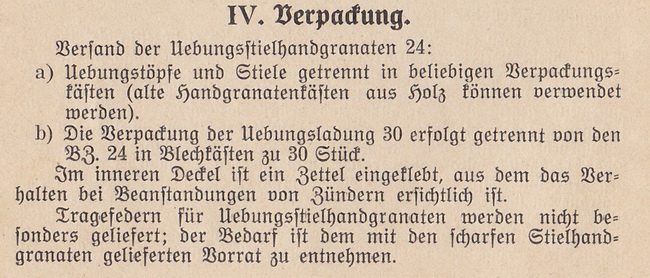 The text above is from the 1940 dated manual named "Waffentechnische Unterrichtsbuch" by Schmitt. It states that the Übungs-Stielhandgranate 24 did not come in a special box, but old transportation boxes for the Stielhandgranate 24 could be used. Also worth noting is the information that "Tragefedern for Übungs-Stielhandgranaten will not be delivered, the units must use the ones supplied for the Stielhandgranaten 24." During training maneuvers in 1928 it was reported that too few of the special springs were available for the troops.  The same publication also describes the Trageöse and the fact that it will be discontinued, 7 years after it actually was removed from production.... A Übungs-Stielhandgranate resembling the Stielhandgranate 43 has never been observed, but 1944 dated Übungsstielhandgranate 24 are quite common, so it is very likely that a training version of the Stielhandgranate 43 was never manufactured. 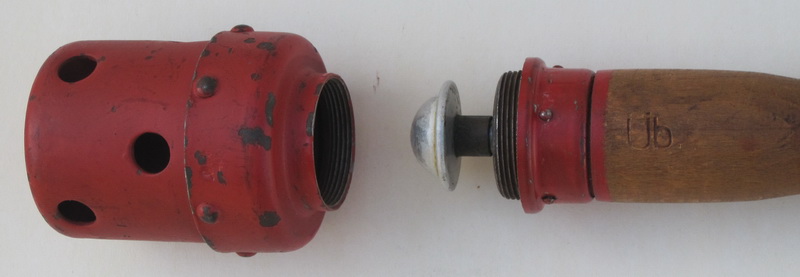 Picture courtesy of Moss og Rygge Krigsminnesamling The picture above shows a brb 40 Übungs-Stielhandgranate 24 with the Übungsladung 30 installed. 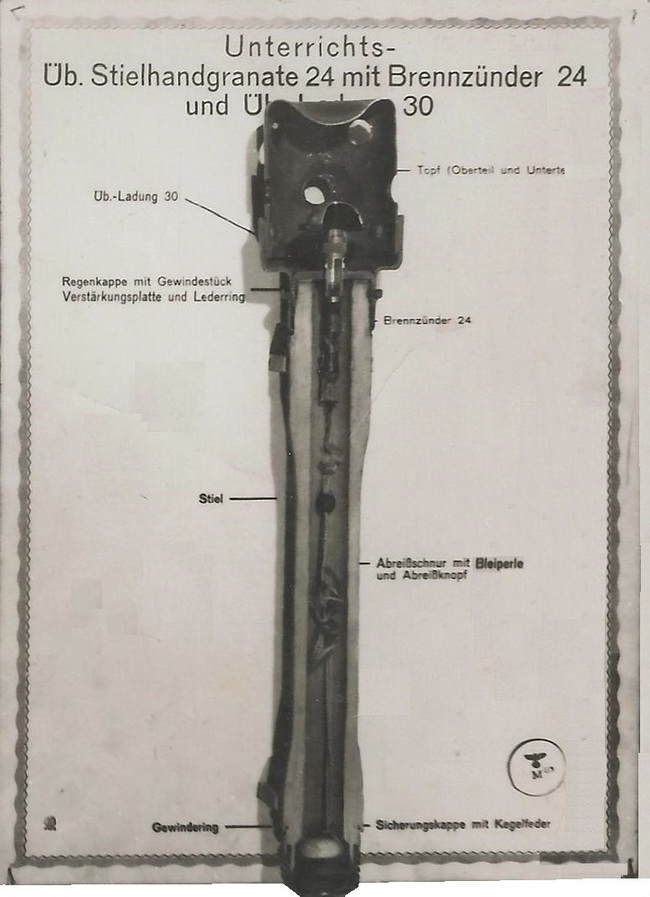 Picture courtesy of Tighe, USA A training chart displaying a cut-through Übungs-Stielhandgranate 24 with a Brennzünder 24 and a Übungsladung 30. Note the small ink stamped "ЯR" down in the left corner representing the maker Richard Rinker. In the lower right corner is an even more interesting stamp. An eagle over a large "M" has been stamped in ink to show that the training chart was the property of the Kriegsmarine. 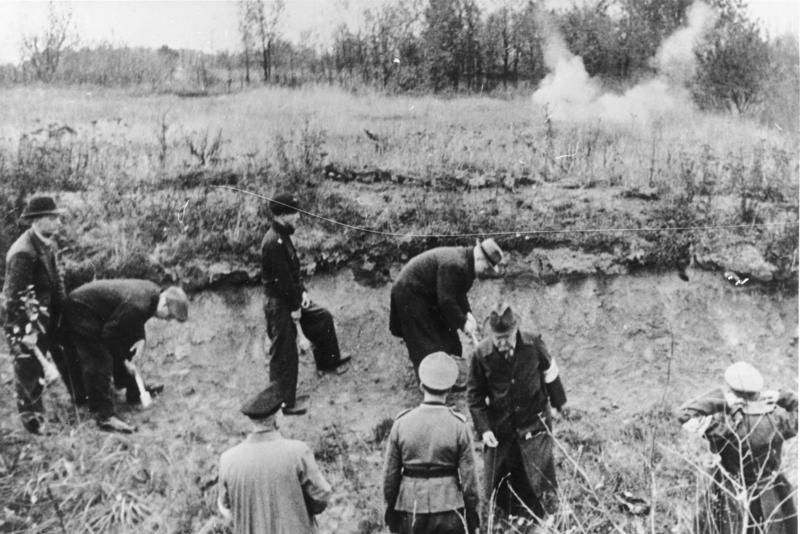 Volksturm personnel training with handgrenades. Picture was taken in Eastern Prussia in late 1944 by Kriegsberichter H. Keiner. Go back to the Stielhandgranate 24 menu |
| Home | For sale | Site map | Contact information | Guest book | Stielhandgranate 24 menu |